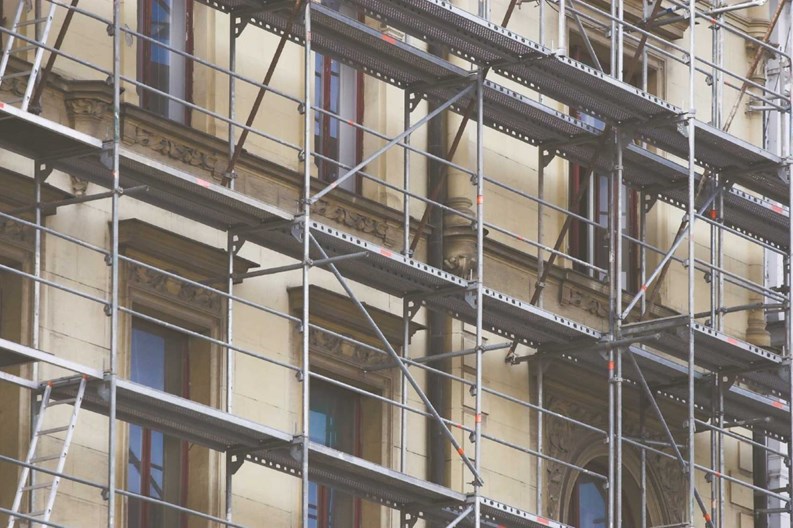Local Law 11 inspection is a requirement of the New York City Department of Buildings that every owner of a building higher than six stories must retain an architect or engineer to inspect their façades. Based on this inspection, a report must be filed documenting findings and making recommendations of any required repairs in order to maintain a building’s exterior in a safe condition. As part of the investigation, the architect or engineer must perform at least one scaffolding drop on a street façade, which may require the assistance of a contractor. This inspection and report is required every five years; the next cycle (Cycle 7) starts in February 2010.
Façade conditions are classified as “safe,” “unsafe,” or “safe with a repair and maintenance program (SWARMP).” Unsafe conditions require immediate notification to the Department of Buildings, protection of the public and remedial action to stabilize it or correct it. Any SWARMP condition from the previous cycle (Cycle 6) that was not corrected will automatically be classified as unsafe with the filing of a new report. SWARMP conditions require repair from one to five years depending on the architect’s or engineer’s recommendation.
Preparing for your Local Law 11 investigation will require the following:
1. If you have not performed your obligated repairs from the previous report, contact a qualified architect or engineer to prepare the required drawings for bidding and DOB submission. The DOB will require building permit information associated with the repairs that were completed from the previous Local Law 11 report.
2. Read your previous Local Law 11 cycle report and look at the conditions to assure their correction. If you can’t find the report, contact your expeditor to obtain a copy of it from the building department. You should do this well in advance of the actual filing date to allow sufficient time to correct the conditions. Many times cracked glass, loose store awnings, and other simple, miscellaneous items are excluded from the restoration contractor’s work because the building management has committed to its repair. Assuring corrections have been made will save the embarrassments of the inspector classifying it as “unsafe.”
3. Buildings should have policies about wall air conditioners that extend beyond the exterior wall. These protruding units should have exterior brackets as recommended by DOB. Loose items on window sills that attempt to provide level base sitting areas for these units will not be acceptable. This can be a problematic issue when each unit owner installs their own units, each of which may differ in size and attachment. The architect or engineer cannot classify this condition as safe if he or she knows that it violates the DOB recommendation.
4. The building manager should ask building occupants to remove all flower pots and other items from window sills, even in discreet areas such as rear or courtyard facades. Loose debris should be removed from the roofs. Update any maintenance contracts and inspections with signage, lighting, flagpole, satellite dishes, etc. prior to the Local Law 11 inspection, and provide a copy of the report to the inspector.
5. Select a qualified architect or engineer to perform the Local Law 11 inspections and report. An experienced facade restoration architect and engineer will be able to observe a condition and not over react or under react to it. For example: a marginally deteriorated sealant joint around a window perimeter, that is not causing leaks or deterioration of wall conditions, can be mentioned in the report under water tightness of the façade, as opposed to being classified as a SWARMP condition, which may lead to an expensive repair project. On the other hand, a deteriorated sealant joint with rust stains at a protruding terra cotta cornice would justify correction of this water entry point before the underlying steel becomes significantly corroded.
To be assured of selecting an architectural or engineering firm that can provide a comprehensive inspection that fulfills the Department of Building requirements for Local Law 11, provides building owner with an overview of the general state of the building façade and roof and specifically describes any defects that must or should be required and a prioritization of repairs, the building management company should request the following qualification:
• The architect or engineer should have of performed at least ten different façade restoration projects with construction values of at least $75,000 in the last three years. It is important to retain a firm that specializes in façade restoration and not just preparation of Local Law 11 reports. There are many firms that perform these reports every five years but are not experienced in façade restoration. Experience in façade restoration projects leads to the knowledge to evaluate the conditions properly.
• The architect or engineer should be able to show the building manager at least three reports from the previous cycle projects. These reports should be prepared in a professional manner with schematic drawings, documenting conditions and photographs to document conditions. Any required repairs should be specifically described as to location, quantity and methodology.
• The architecture or engineering firm should provide the resume of one or two licensed professionals, with relevant façade restoration and Local Law 11 inspection experience, who will actually be performing the inspection. Beware of firms that send junior, inexperienced, unlicensed individuals to perform the inspection.
The goal of the Local Law 11 inspection program from the point of view of the City of New York is to assure safety to the public. The building owner as well subscribes to this concept but will be rewarded if he proceeds in a manner that protects his investment.
Dom Diaz is an architect and president of Diaz Architects, a firm that specializes in building envelope restoration.







Comments
Leave a Comment